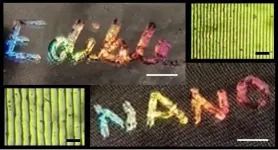Modeling a better catalyst for PIBSAs
Research from Pitt and Lubrizol models reaction to improve fuel and lubricant additive production
2021-02-17
(Press-News.org) Polyisobutenyl succinic anhydrides (PIBSAs) are important for the auto industry because of their wide use in lubricant and fuel formulations. Their synthesis, however, requires high temperatures and, therefore, higher cost.
Adding a Lewis acid--a substance that can accept a pair of electrons--as a catalyst makes the PIBSA formation more efficient. But which Lewis acid? Despite the importance of PIBSAs in the industrial space, an easy way to screen these catalysts and predict their performance hasn't yet been developed.
New research led by the Computer-Aided Nano and Energy Lab (CANELa) at the University of Pittsburgh Swanson School of Engineering, in collaboration with the Lubrizol Corporation, addresses this problem by revealing the detailed mechanism of the Lewis acid-catalyzed reaction using computational modeling. The work, recently featured on the cover of the journal Industrial & Engineering Chemistry Research, builds a deeper understanding of the catalytic activity and creates a foundation for computationally screening catalysts in the future.
"PIBSAs are commonly synthesized through the reaction between maleic anhydride and polyisobutene. Adding Lewis acids makes the reaction faster and reduces the energy input required for PIBSA formation," explained Giannis Mpourmpakis, the Bicentennial Alumni Faculty Fellow and associate professor of chemical and petroleum engineering at Pitt. "But the reaction mechanism has not been well understood, and there are not many examples of this reaction in the literature. Our work helps to explain the way the reaction happens and identifies Lewis acids that will work best."
This new foundational information will aid in the discovery of Lewis acid catalysts for industrial chemical production at a faster rate and reduced cost.
"The alliance between the University of Pittsburgh and Lubrizol has been instrumental in demonstrating how Academia and the Chemical Process Industry can work together to produce commercially relevant results," said Glenn Cormack, Global Process Innovation Manager at The Lubrizol Corporation. "Combining the knowledge and expertise of the Swanson School of Engineering and The Lubrizol Corporation allows both parties access to some of the best available computational and experimental techniques when exploring new challenges."
The research is one of many collaborations between Pitt and the Lubrizol Corporation, an Ohio-based specialty chemical provider for transportation, industrial and consumer markets. The alliance with Lubrizol, now in its seventh year, provides students with hands-on opportunities to experience how the knowledge and skills they're developing are used in the chemical industry. At the same time, students gain world-ready knowledge how Pitt's research helps improve Lubrizol's processes and products.
"Over the last few years, our partnership with Lubrizol has led to new, innovative ways for Lubrizol to make products and rethink their manufacturing processes," said Steven Little, William Kepler Whiteford Endowed Professor and chair of the Department of Chemical and Petroleum Engineering. "We learn a tremendous amount from them as well, and all of these publications are evidence of an alliance that continues to grow."
The paper, "Computational Screening of Lewis Acid Catalysts for the Ene Reaction between Maleic Anhydride and Polyisobutylene," (DOI: 10.1021/acs.iecr.0c04860 ) was published in the ACS journal I&EC Research. It was authored by Cristian Morales-Rivera and Giannis Mpourmpakis at Pitt and Nico Proust and James Burrington at the Lubrizol Corporation.
INFORMATION:
ELSE PRESS RELEASES FROM THIS DATE:
2021-02-17
Wearable sleep tracking devices - from Fitbit to Apple Watch to never-heard-of brands stashed away in the electronics clearance bin - have infiltrated the market at a rapid pace in recent years.
And like any consumer products, not all sleep trackers are created equal, according to West Virginia University neuroscientists.
Prompted by a lack of independent, third-party evaluations of these devices, a research team led by Joshua Hagen, director of the Human Performance Innovation Center at the WVU Rockefeller Neuroscience Institute, tested the efficacy of eight commercial sleep trackers.
Fitbit and Oura came out on top in measuring total sleep time, total wake ...
2021-02-17
SAN ANTONIO -- Patients should be assessed for frailty before having many types of surgery, even if the surgery is considered low risk, a review of two national patient databases shows.
Frailty is a clinical syndrome marked by slow walking speed, weak grip, poor balance, exhaustion and low physical activity. It is an important risk factor for death after surgery, although the association between frailty and mortality across surgical specialties is not well understood.
The study, conducted by faculty at multiple institutions including The University of Texas Health Science Center at San Antonio (UT Health San Antonio), mined patient data from the Veterans Affairs (VA) Surgical Quality Improvement Program and the American College of Surgeons (ACS) National Surgical Quality ...
2021-02-17
The millions of people affected by 2020's record-breaking and deadly fires can attest to the fact that wildfire hazards are increasing across western North America.
Both climate change and forest management have been blamed, but the relative influence of these drivers is still heavily debated. The results of a recent study show that in some ecosystems, human-caused climate change is the predominant factor; in other places, the trend can also be attributed to a century of fire suppression that has produced dense, unhealthy forests.
Over the past decade, fire scientists have made major progress in understanding climate-fire relationships at large scales, such as across western North America. But a new paper published in the journal Environmental Research ...
2021-02-17
ROCHESTER, Minn. -- Mayo Clinic researchers have developed a novel proton therapy technique to more specifically target cancer cells that resist other forms of treatment. The technique is called LEAP, an acronym for "biologically enhanced particle therapy." The findings are published today in Cancer Research, the journal of the American Association for Cancer Research.
"The human body receives tens of thousands of DNA lesions per day from a variety of internal and external sources," says Robert Mutter, M.D., a radiation oncologist at Mayo Clinic and co-principal investigator of the study." Therefore, cells have evolved complex repair pathways to efficiently repair damaged DNA. Defects in these repair pathways ...
2021-02-17
With the seemingly unstoppable advancement in the fields of miniaturization and materials science, all sorts of electronic devices have emerged to help us lead easier and healthier lives. Wearable sensors fall in this category, and they have received much attention lately as useful tools to monitor a person's health in real time. Many such sensors operate by quantifying biomarkers, that is, measurable indicators that reflect one's health condition. Widely used biomarkers are heartrate and body temperature, which can be monitored continuously with relative ease. On the contrary, ...
2021-02-17
Holograms are everywhere, from driver's licenses to credit cards to product packaging. And now, edible holograms could someday enhance foods. Researchers reporting in ACS Nano have developed a laser-based method to print nanostructured holograms on dried corn syrup films. The edible holograms could also be used to ensure food safety, label a product or indicate sugar content, the researchers say.
Most holograms are imprinted with lasers onto metal surfaces, such as aluminum, but the materials aren't edible. For foods, holograms made with nanoparticles have been proposed, but the tiny particles can generate reactive oxygen species, which might be harmful for people to eat. In a different approach, food scientists have ...
2021-02-17
ROCHESTER, Minn. -- A new study by Mayo Clinic researchers has identified that a chromosome instability gene, USP24, is frequently missing in pediatric patients with neuroblastoma, an aggressive form of childhood cancer. The finding provides important insight into the development of this disease. The study is published in Cancer Research, the journal of the American Association for Cancer Research.
"Neuroblastoma is a highly aggressive cancer that nearly exclusively affects young children," says Paul Galardy, M.D., a pediatric hematologist and oncologist at Mayo Clinic. Despite the use of multiple treatment approaches, Dr. Galardy says many children die of this disease every year.
To identify new ...
2021-02-17
A mutation in the spike protein of SARS-CoV-2--one of several genetic mutations in the concerning variants that have emerged in the United Kingdom, South Africa, and Brazil--makes the virus up to eight times more infectious in human cells than the initial virus that originated in China, according to research published in the journal END ...
2021-02-17
Scientists have discovered a never-before-seen biodiversity pattern of coral reef fishes that suggests some fishes might be exceptionally vulnerable to environmental change.
A new study shows plankton-eating coral reef fishes (planktivores) are far more diverse than others in the Indo-Australian Archipelago, a global marine biodiversity hotspot.
The findings highlight, for the first time, a unique link between the diet and distribution of species across the marine realm.
"The archipelago is one of the most complex and dynamic geological regions in the tropics," said lead author Dr Ale Siqueira from the ARC Centre of Excellence for Coral Reef Studies at James Cook University (Coral CoE at JCU). "And its ...
2021-02-17
Teens who bully, harass, or otherwise victimize their peers are not always lashing out in reaction to psychological problems or unhealthy home environments, but are often using aggression strategically to climb their school's social hierarchy, a University of California, Davis, study suggests. These findings point to the reasons why most anti-bullying programs don't work and suggest possible strategies for the future.
"To the extent that this is true, we should expect them to target not vulnerable wallflowers, but their own friends, and friends-of-friends, who are more ...
LAST 30 PRESS RELEASES:
[Press-News.org] Modeling a better catalyst for PIBSAs
Research from Pitt and Lubrizol models reaction to improve fuel and lubricant additive production




